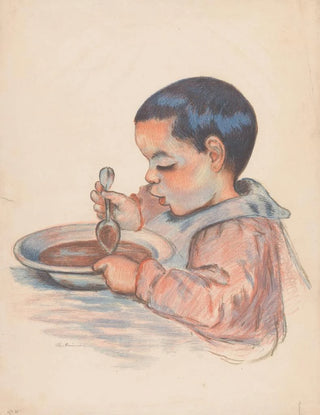Art print | Child eating soup - Armand Guillaumin


View from behind

Frame (optional)
In the rich and captivating world of impressionist art, the artwork "Child Eating Soup" by Armand Guillaumin stands out for its touching simplicity and emotional depth. This painting, capturing a moment of everyday life, evokes tenderness and childhood vulnerability. Through the gaze of a child absorbed in their meal, Guillaumin invites us to reflect on fleeting moments in life, while celebrating the beauty of everyday gestures. The soft light bathing the scene and the vibrant colors transport us to a world where every detail matters, where ordinariness transforms into visual poetry. This piece, though modest in subject, resonates with an evocative power that leaves no one indifferent.
Style and uniqueness of the work
Guillaumin's style, characterized by bold brushstrokes and a luminous palette, gives "Child Eating Soup" an atmosphere that is both intimate and vibrant. The warm tones of the artwork, blending shades of yellow, orange, and red, create a welcoming ambiance that envelops the viewer. The composition, centered on the child, immediately draws the eye and allows us to feel the concentration of the subject on their meal. The details, though treated with a certain speed, reveal meticulous attention to expressions and gestures. This approach, typical of impressionism, emphasizes the importance of the present moment, capturing a fleeting emotion that might otherwise go unnoticed. Thus, Guillaumin succeeds in transcending the simple act of eating to create a lively and meaningful work of art.
The artist and his influence
Armand Guillaumin, often overshadowed by contemporaries such as Monet or Renoir, deserves a prominent place in art history. Born in 1841, he was an active member of the impressionist movement, contributing to its development while bringing his own unique vision. Guillaumin was always interested in the representation of light and color, exploring various themes ranging from landscapes to scenes of everyday life. His influence is felt not only

Matte finish

View from behind

Frame (optional)
In the rich and captivating world of impressionist art, the artwork "Child Eating Soup" by Armand Guillaumin stands out for its touching simplicity and emotional depth. This painting, capturing a moment of everyday life, evokes tenderness and childhood vulnerability. Through the gaze of a child absorbed in their meal, Guillaumin invites us to reflect on fleeting moments in life, while celebrating the beauty of everyday gestures. The soft light bathing the scene and the vibrant colors transport us to a world where every detail matters, where ordinariness transforms into visual poetry. This piece, though modest in subject, resonates with an evocative power that leaves no one indifferent.
Style and uniqueness of the work
Guillaumin's style, characterized by bold brushstrokes and a luminous palette, gives "Child Eating Soup" an atmosphere that is both intimate and vibrant. The warm tones of the artwork, blending shades of yellow, orange, and red, create a welcoming ambiance that envelops the viewer. The composition, centered on the child, immediately draws the eye and allows us to feel the concentration of the subject on their meal. The details, though treated with a certain speed, reveal meticulous attention to expressions and gestures. This approach, typical of impressionism, emphasizes the importance of the present moment, capturing a fleeting emotion that might otherwise go unnoticed. Thus, Guillaumin succeeds in transcending the simple act of eating to create a lively and meaningful work of art.
The artist and his influence
Armand Guillaumin, often overshadowed by contemporaries such as Monet or Renoir, deserves a prominent place in art history. Born in 1841, he was an active member of the impressionist movement, contributing to its development while bringing his own unique vision. Guillaumin was always interested in the representation of light and color, exploring various themes ranging from landscapes to scenes of everyday life. His influence is felt not only






